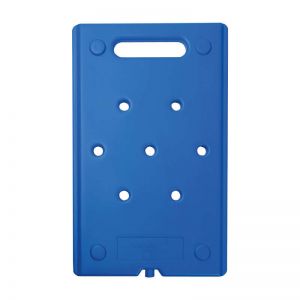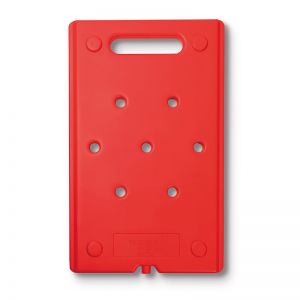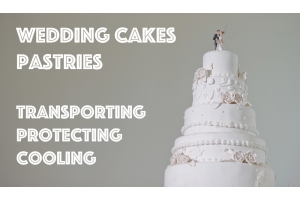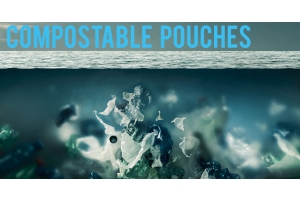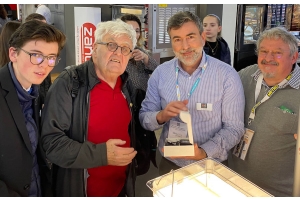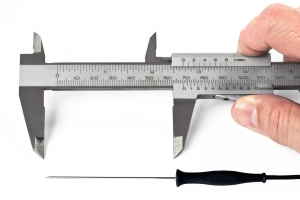Everything you need to know about Cool Pack and Hot Pack (Eutectic Plates)
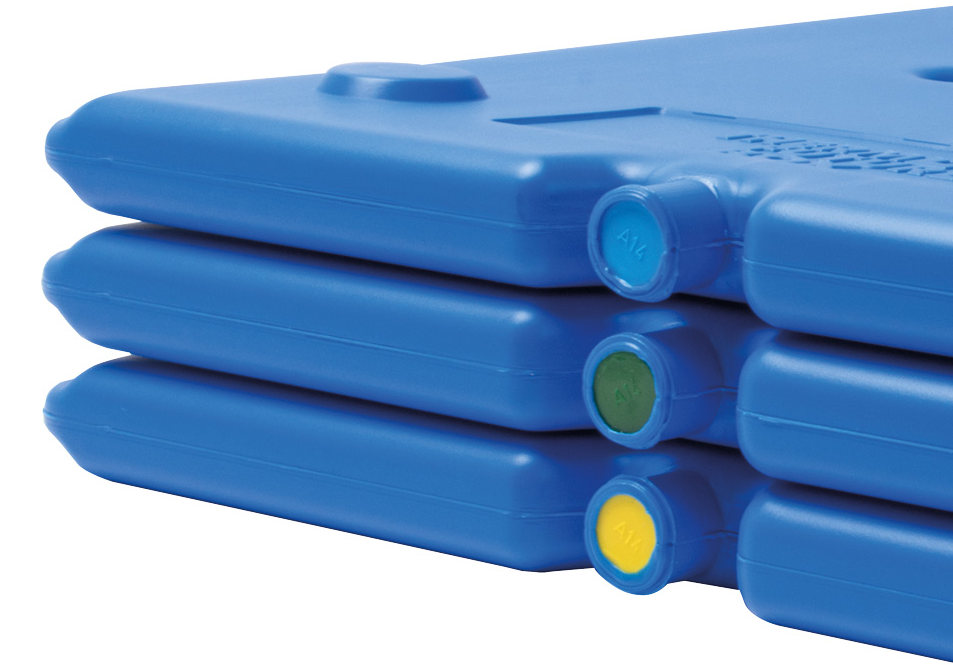
What is an Eutectic plate?
The word Eutectic comes from the Greek -eútēktos- which means "which melts easily". It is a mixture of products (minerals, pure substances) which mainly has 2 characteristics:
- it changes from the solid state to the liquid state releasing energy in a constant manner AND for a given temperature range,
- regarding cooling eutectic gels it is possible to reach much lower temperatures (-21°C, -5.8°F) than that of frozen water (0°C, 32°F).
For example, a bottle of frozen water in your cooler will allow you to lower the temperature of its contents but will result in freezing the food located nearby with strong temperature variations during the coolng down period of time.
A cooling accumulator (or cooler pack) containing a liquid or an eutectic gel will react differently from the frozen bottle:
- the eutectic mixture is "set" for a specific temperature range. For example 0 to +6°C for fresh products, 0 to +4°C for cold products or -21 to -15°C for frozen products,
- the cold released by the eutectic mixture will occur gradually and constantly without freezing the food located nearby (except of course for the eutectic mixtures "set" for a temperature range below 0°C).
The graph below illustrates the gradual release of cold from a Thermo Future Box brand eutectic plate -12°C (cold foods between 0°C and +4°C). The red line indicates the external temperature of the Thermobox (16°C to 18°C), the blue line indicates the temperature of the eutectic plate itself and the green line the average temperature measured in the Thermobox. The time line (abcissa) is expressed in minutes.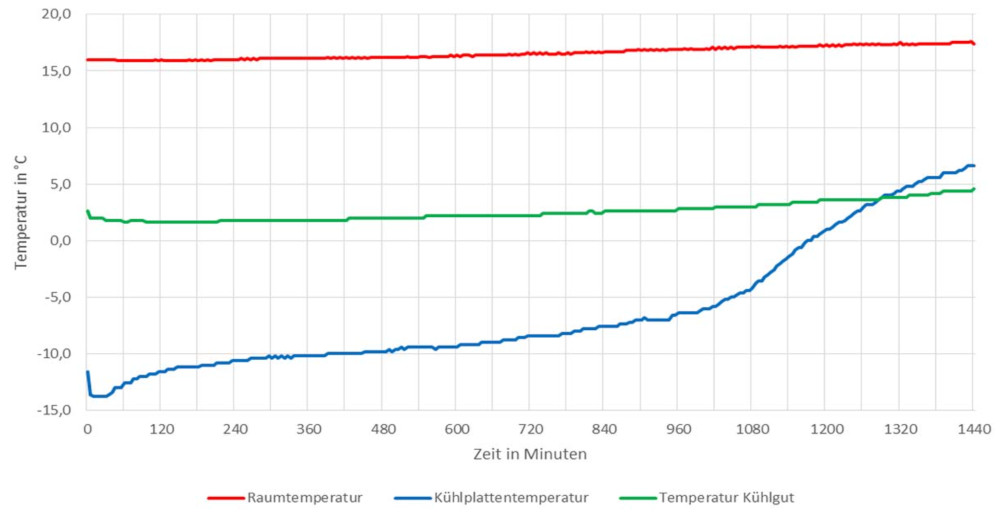
Cold accumulators containing a eutectic mixture are therefore technical devices which ensure food, catering or pharmacy professionals stability and accuracy of the temperature of their products during transport in Thermoboxes.
The above remarks also apply to the heat accumulators used to ensure hot dishes remain above 63°C during transportation. Heat accumulators are a little less popular with professionals than cold accumulators. Indeed, it is easier for cateres to manage the transport of cold disches that hot ones which are more risky in terms of the development of pathogenic germs and regulation compliance.
Eutectic gel or liquid? Which one should you choose for the transport of your fresh, cold or frozen products?
Consumer cold packs contain water only without any eutectic mixture. They are cheap but will not meet your expectations for the reasons given above. They are therefore to be avoided.
An eutectic gel , compared to an eutectic liquid, contains a viscous agent which allows the eutectic mixture to be preserved in a homogeneous and stable manner in the plastic envelope which surrounds it.
This is an important criterion, especially during the freezing phase of the eutectic plate, which will contribute to ensuring a homogeneous and constant release of the cold during the transport of the foodstuffs. For this reason the eutectic gel must be preferred.
Optimizing the performance of eutectic plates and mistakes to avoid
The quality of the container in which the foodstuffs and the cold or heat accumulators will be transported will be decisive for the stability of the temperature of your products. Thermobox containers type are made of expanded polypropylene (PPE). They are light, shock-resistant and highly insulating. EPP insulated containers are preferred over containers with a plastic shell which are heavy, sensitive to shocks and expensive.
An insulated container must be fully filled to optimize the stability of its inside temperature (cold or hot). A half-filled Thermobox will retain cold or hot for less time than if it is completely full. It is nevertheless possible to overcome this problem by adding a separator (insulation) or another eutectic plate just above (or below) the foodstuffs contained in your Thermobox.
Obviously, a cold eutectic plate will have to be placed above the foodstuffs (the cold goes down) while a hot eutectic plate will be placed in the lower part of the isothermal container (the heat goes up).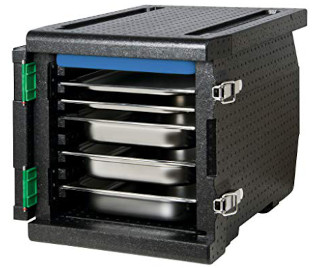

For Thermoboxes that can contain gastronorm containers, you can find on the market special supports or lids allowing to add one or several cold accumulators.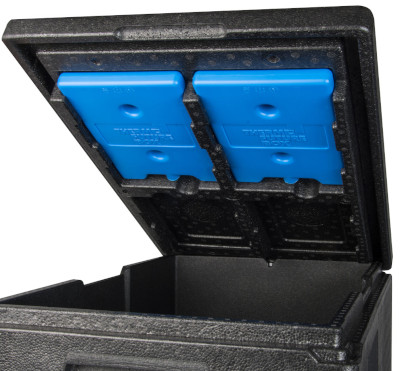

It is also possible to optimize the efficiency of an eutectic plate by placing, upstream, accumulators in your thermoboxes in order to cool (or heat) the thermoboxe walls. New eutectic plates must replace the plates used for "pre-cooling" (or pre-heating) the thermobox when filling the thermobox with the foodstuffs.
Do not confuse the "cold power or capacity" of an eutectic plate with the number of eutectic plates you have in a thermobox. In other words, adding several cold or hot accumulators will not increase or decrease the temperature of the contents of your thermobox. Two eutectic plates -15°C will realease the same temperature as a single plate. On the other hand, placing several eutectic plates in an insulated container will, under certain conditions, increase the holding time at this temperature.
Freezing process of the cold eutectic plates
It is essential to respect the freezing temperature recommended for an eutectic plate.
For information, you will find below the ranges of temperatures released by Thermo Future Box's cold accumulators as well as the freezing temperatures and times recommended according to the model of eutectic plate.
| TYPE OF PLATE | RELEASED TEMP. | RECOMMENDED FREEZING TEMP. | FREEZING TIME |
|---|---|---|---|
| -3°C FRESH | 0°C to + 6°C | -18°C | 9h |
| -12°C COLD | 0°C to +4°C | -18°C | 24h (or 16h at -22°C) |
| -21°C FROZEN | -21°C to -15°C | -27°C | 24h |
The freezing time of an eutectic plate is also important. However, if the freezing time has not been 100% respected, this will not affect the release temperature range of your eutectic plate but rather its "autonomy" during transport in the Thermobox. In other words, if you know that you need to cool the contents of your Thermobox for only 30 minutes, it is not necessary to freeze an eutectic plate for 24 hours...
For the freezing of eutectic plates to take place under good conditions, it is necessary that the plates are not stuck to each other and that air circulates between the plates. Prefer the eutectic plates with integrated spacers like those of Thermo Future Box. To check if an eutectic plate is well frozen, vigorously shake the plate. If you feel something moving inside, the eutectic gel is not frozen to the core.
Once frozen, the eutectic plates are sensitive to shocks, handle them with care.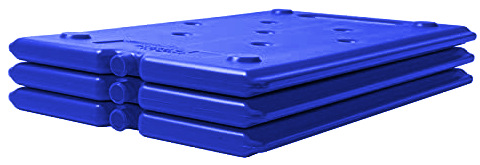
Heating process of hot eutectic plates
Installation advice before adding a hot eutectic plate in a thermobox
We recommend that you heat the thermobox beforehand with a hot eutectic plate before placing the hot dishes in it and starting the delivery. Fifteen to twenty minutes is enough. The ideal is to replace the plate used to "preheat" the thermobox with a new hot plate before starting delivery. This good practice will allow you to optimize the heat releasing time of the hot plate.
How to heat up hot eutectic plates in an oven?
A combi or convection oven can be used to heat eutectic plates.
NEVER use a microwave oven to heat up an eutectic plate, except for plates specially made for this purpose.
- Place the eutectic plates horizontally on the metal plate or grid of the oven, previously covered with aluminum foil.
- NEVER use the "grill" function of the oven, otherwise you will damage the eutectic plate and the oven. In general, never put an eutectic plate in direct contact with a heat source.
- Oven temperature: 95°C max.
- Duration: 90 minutes max.
- When it comes out of the oven, handle the eutectic plate with care. Once hot, the eutectic plate is sensitive to shocks. Always handle the eutectic plate so that the cap is facing up, away from your face.
- To avoid burning yourself, wear gloves.
- Check the general appearance of the eutectic plate before placing it in the insulated container.
Note: if you want to heat up several eutectic plates at the same time, make sure that the heat transfer is optimum. Leave a small space between the plates so that the hot air circulates between the plates. Use hot accumulators with spacers molded into the plates. So you can stack the eutectic plates in your oven.
Comment remettre en température votre plaque eutectique chaude dans un bain-marie?
It is a very effective solution which will avoid monopolizing your combi oven and avoid any risk of alteration of the eutectic plate by direct contact with an excessive heat source (grill, oven...). The ideal is to use a stirred bain-marie or an immersion circulator attached to a GN container.
- Place the eutectic plates in your water bath so that the water circulates correctly between the plates. To optimize heat transfer, we recommend that you place a pastry rack at the bottom of your container and add the eutectic plates on top. Plates can be positioned vertically.
- Water bath temperature: 90°C max.
- Duration: 90 minutes max.
- ATTENTION: for the gel of the eutectic plate to reach its optimal temperature of use, it is necessary to immerse the eutectic plates in the bain-marie at the precise moment when the latter has reached 90°C and for about 90 minutes.
- When removing the eutectic plates from the bain-marie, handle them with care. Once hot, the eutectic plates are sensitive to shocks. Always handle the eutectic plate so that the cap is facing up, away from your face.
- To avoid burning yourself, wear gloves.
- Check the general appearance of the eutectic plate before placing it in the insulated container.
The graph below illustrates the time required to heat up a hot Thermo Future Box brand eutectic plate in an oven or water bath at 95°C. The red line indicates the temperature of the oven or water bath, the blue line indicates the temperature of the eutectic plate itself. The time line (abcissa) is expressed in minutes.
Cleaning cold eutectic plates
CAUTION: do not expose cold eutectic plates to temperatures below -45°C or above 50°C. Failing this would irreparably alter their cooling capacity.
Therefore, an eutectic plate should not be cleaned in the dishwasher or with too hot water.
